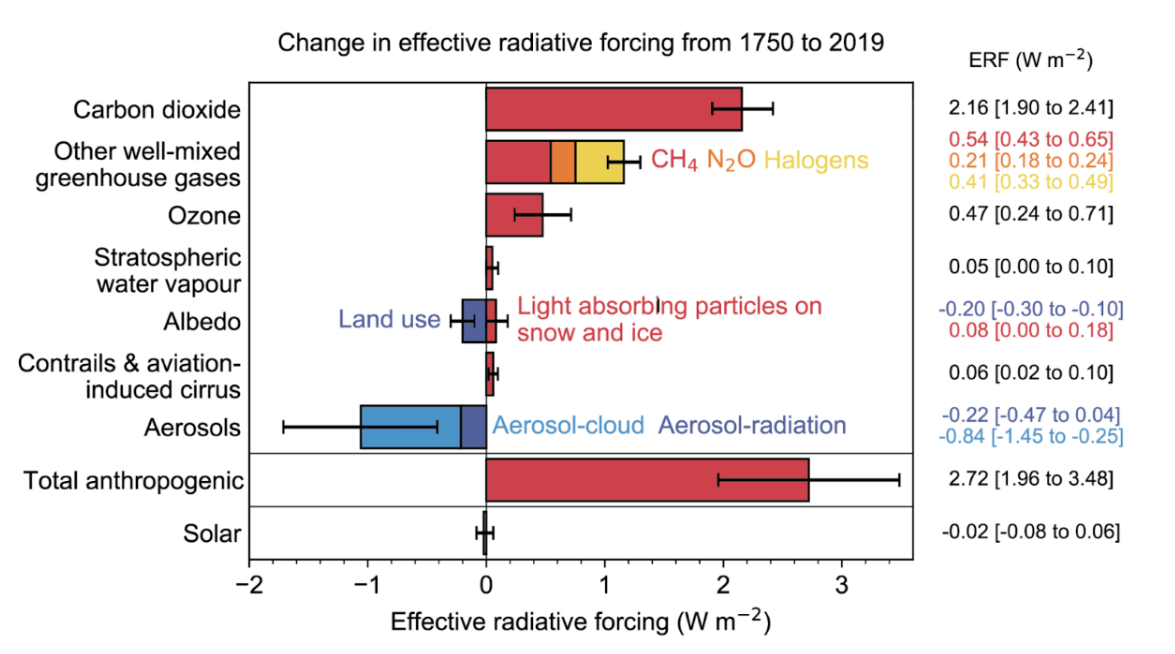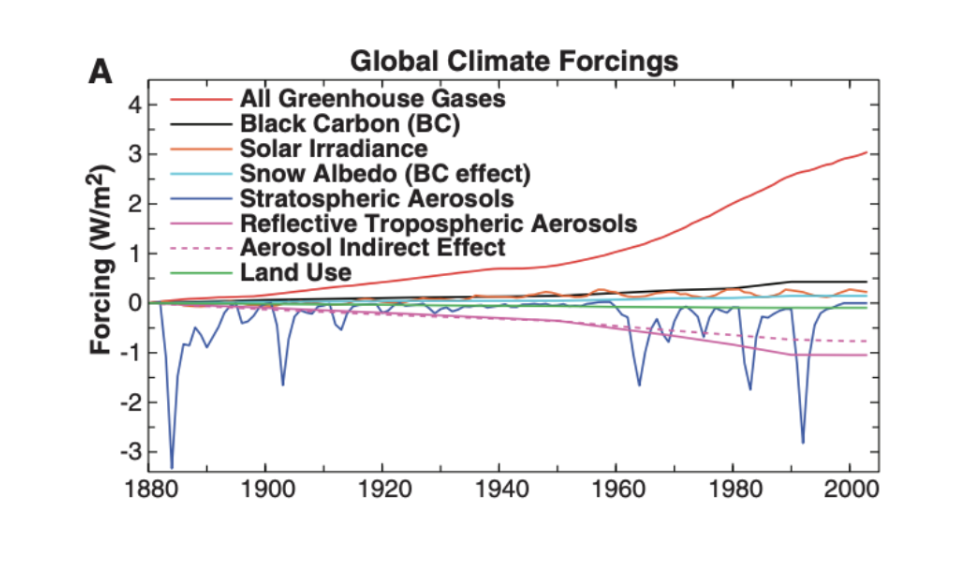Understanding the drivers of contemporary climate change beyond CO₂


· 6 min read
Although the focus of the climate change debate is on mitigating carbon dioxide (CO₂) levels, it is important to remember that contemporary climate change is a function of multiple radiative forcings (RFs). In simple terms, RF is a concept used in climate science to quantify changes in the energy balance in the Earth's atmosphere. Several drivers contribute to the Earth’s current radiative imbalance, where the Earth’s solar energy absorption outweighs the energy radiated back into space. For instance, well-mixed greenhouse gases (GHGs) such as methane (CH₄), nitrous oxide (N₂O), and halocarbons have a RF which cannot be ignored. Even though the focus on CO₂ emissions makes sense, as these have been the main driver of global warming since the pre-industrial period (IPCC, 2021), this article will uncover the extent to which non-CO₂ drivers affect the contemporary radiative imbalance.
The concentration of atmospheric CH₄ has risen more than 150% since pre-industrial times, compared to 50% for CO₂ according to the Mauna Loa Observatory in Hawaii. The main culprits behind this rise in CH₄ include the increased number of ruminants, emissions from fossil fuel extraction and use, the expansion of rice paddy agriculture and emissions from landfills, waste and biomass burning. Admittedly, humans have changed the climate by expanding, directly or indirectly, the anoxic areas where microbes known as methanogens can decompose biomass and produce methane (Dean et al., 2018). Because of its high global warming potential (more than 27 times higher than CO₂ over a 100-year period), feedback mechanisms resulting in non-linear increases of atmospheric methane are worrying. Indeed, an excessive rise in temperature may lead to increased permafrost thawing and warming of wetland peat, which can lead to the destabilisation of methane hydrates and release CH₄ bubbles (O’Connor et al., 2010). These could uncontrollably increase the levels of atmospheric CH₄, resulting in a greater positive RF, warming the planet even more and enhancing methanogenic activity once again. Major uncertainties prevail regarding the timescales and magnitudes of these methane feedback loops. However, it is imperative to recognise the far-reaching consequences of these processes. As illustrated in Figure 1 below, methane emissions have already caused a quite significant positive RF of 0.54 W/m² relative to 1750.

Figure 1. RF of different emitted compounds relative to 1750, in W/m² (IPCC, 2021)
Human-made halocarbon compounds such as chlorofluorocarbons (CFC's) have also hastened contemporary climate change as they have strong infra-red absorbing capabilities and often have long atmospheric lifetimes (Forster and Joshi, 2005). Although they have caused some cooling by depleting the ozone, stratospheric halocarbon emissions are estimated to have caused a positive RF of around 0.41 W/m² (IPCC, 2021). Additionally, emissions of N₂O due mainly to nitrogen fertilisation of agricultural soils and fuel combustion are estimated to have a RF of 0.21 W/m² (IPCC, 2021). Adding up the RFs of CH₄, N₂O and halocarbons gives a positive RF of 1.16 W/m². Ozone is also estimated to add to this positive effect by increasing the RF by approximately 0.47 W/m². Comparing these with the RF of CO₂ (2.16 W/m²), non-CO₂ GHGs have a significant impact on the Earth’s radiative imbalance which should not be overlooked.
On the other hand, compounds having a significant cooling effect are aerosols such as sulphate, mineral dust and organic carbon, which have a net cooling effect due to their low albedo. Aerosols act as cloud condensation nuclei, raising atmospheric reflectivity and cloud formation which decreases the global RF. However, as can be seen by the confidence interval on Figure 1, the effect of aerosols on climate change and their exact RF remains immensely uncertain due to their spatial heterogeneity and the complex ways they interact with radiation and clouds (Myhre et al., 2013). The variation across time in the cooling effect of stratospheric sulfur aerosols can be seen in Figure 2, providing some interesting insights. These aerosols, which can be emitted by volcanoes, have historically led to quite abrupt negative global RFs due to their reflectivity. Indeed, major cooling episodes can be explained by the eruptions of Mount Pinatubo (1991) and Krakatoa (1883), which were accompanied by a rapid global cooling that persisted for decades after the event (Hansen et al., 2010; Gleckler et al., 2006).

Figure 2. Global climate forcings from 1880 to 2005 (Hansen et al., 2005)
Another important compound which can be seen on the Figure is black carbon, a byproduct of incomplete combustion, which according to some estimates is the second or third largest contributor to global warming due to its low albedo (Wallack and Ramanathan, 2009). It has been suggested to increase the melting of the cryosphere as much as CO₂ emissions, particularly in the Tibetan Plateau (Zhang et al., 2015). It is also a significant health hazard, making it a more credible and straightforward target for climate regulation.
To conclude, contemporary climate change is caused mainly by, but not restricted to atmospheric CO₂ concentrations. Many other gases and aerosols (black carbon, N₂O, CH₄, CFC’s), affect the current radiative imbalance (and subsequent global warming) of our planet. Effective climate mitigation policies must therefore address a range of greenhouse gases and aerosols, considering their diverse sources and impacts.
illuminem Voices is a democratic space presenting the thoughts and opinions of leading Sustainability & Energy writers, their opinions do not necessarily represent those of illuminem.
Dean, J. F., Middelburg, J. J., Röckmann, T., Aerts, R., Blauw, L. G., Egger, M., ... & Dolman, A. J. (2018). Methane feedbacks to the global climate system in a warmer world. Reviews of Geophysics, 56(1), 207-250.
Forster, P. M. D. F., & Joshi, M. (2005). The role of halocarbons in the climate change of the troposphere and stratosphere. Climatic Change, 71(1-2), 249-266.
Gleckler, P. J., Wigley, T. M. L., Santer, B. D., Gregory, J. M., AchutaRao, K., & Taylor, K. E. (2006). Krakatoa's signature persists in the ocean. Nature, 439(7077), 675-675.
Hansen, J., Ruedy, R., Sato, M., & Lo, K. (2010). Global surface temperature change. Reviews of Geophysics, 48(4).
Huang, K. Leitzell, E. Lonnoy, J.B.R. Matthews, T.K. Maycock, T. Waterfield, O. Yelekçi, R. Yu, and B. Zhou (eds.)]. Cambridge University Press, Cambridge, United Kingdom and New York, NY, USA, In press, doi:10.1017/9781009157896.
IPCC (2014). Climate Change 2014: Synthesis Report. Contribution of Working Groups I, II and III to the Fifth Assessment Report of the Intergovernmental Panel on Climate Change [Core Writing Team, R.K. Pachauri and L.A. Meyer (eds.)]. IPCC, Geneva, Switzerland, 151 pp.
IPCC (2021). Climate Change 2021: The Physical Science Basis. Contribution of Working Group I to the Sixth Assessment Report of the Intergovernmental Panel on Climate Change[Masson-Delmotte, V., P. Zhai, A. Pirani, S.L. Connors, C. Péan, S. Berger, N. Caud, Y. Chen, L. Goldfarb, M.I. Gomis, M.
Myhre, G., Samset, B. H., Schulz, M., Balkanski, Y., Bauer, S., Berntsen, T. K., ... & Zhou, C. (2013). Radiative forcing of the direct aerosol effect from AeroCom Phase II simulations. Atmospheric Chemistry and Physics, 13(4), 1853-1877.
O'Connor, F. M., Boucher, O., Gedney, N., Jones, C. D., Folberth, G. A., Coppell, R., ... & Johnson, C. E. (2010). Possible role of wetlands, permafrost, and methane hydrates in the methane cycle under future climate change: A review. Reviews of Geophysics, 48(4).
Ramanathan, V., & Carmichael, G. (2008). Global and regional climate changes due to black carbon. Nature geoscience, 1(4), 221-227.
Wallack, J. S., & Ramanthan, V. (2009). The other climate changers: Why black carbon and ozone also matter. Foreign Aff., 88, 105.
Zhang, R., Wang, H., Qian, Y., Rasch, P. J., Easter, R. C., Ma, P. L., ... & Fu, Q. (2015). Quantifying sources, transport, deposition, and radiative forcing of black carbon over the Himalayas and Tibetan Plateau. Atmospheric Chemistry and Physics, 15(11), 6205-6223.
Gokul Shekar

Effects · Climate Change
illuminem briefings

Mitigation · Climate Change
illuminem briefings

Climate Change · Environmental Sustainability
The Guardian

Agriculture · Climate Change
Euronews

Climate Change · Effects
The Wall Street Journal

Climate Change · Effects